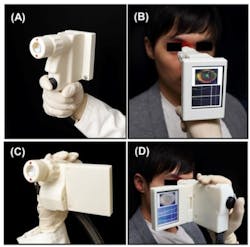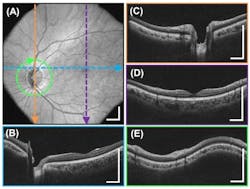| Power-grip-style (A-B) and camcorder-style designs (C-D) of a prototype OCT scanner are shown; both devices acquire 3D OCT images of the retina. (Credit: Biomedical Optics Express) |
| A high-definition OCT image of the retina allows clinicians to noninvasively visualize the 3D structure of key regions, such as the macula (region near the fovea) and optic-nerve head, to screen for signs of disease pathology. Shown here is a widefield view (A) as well as detailed vertical cross sections (B), (C), and (D), and a circular cross-section (E). Credit: (Biomedical Optics Express) |
Although other research groups and companies have created handheld OCT devices using similar technology, the new design is the first to combine ultrahigh-speed 3-D imaging, a microelectromechanical systems (MEMS) mirror for scanning, and a technique to correct for unintentional movement by the patient. These innovations, the authors say, should allow clinicians to collect comprehensive data with just one measurement.
To deal with the motion instability of a handheld device, the instrument takes multiple 3D images at high speeds, scanning a particular volume of the eye many times but with different scanning directions. By using multiple 3D images of the same part of the retina, it is possible to correct for distortions due to motion of the operator’s hand or the subject’s own eye.
They tested two designs, one of which is similar to a handheld video camera with a flat-screen display. In their tests, the researchers found that their device can acquire images comparable in quality to conventional table-top OCT instruments used by ophthalmologists. The next step is to evaluate the technology in a clinical setting, says researcher James Fujimoto of MIT, an author of the paper. But the device is still relatively expensive, he adds, and before this technology finds its way into doctors' offices or in the field, manufacturers will have to find a way to support or lower its cost.
REFERENCE:
1. Chen D. Lu et al., Biomedical Optics Express (2014) http://dx.doi.org/10.1364/BOE.5.000293

